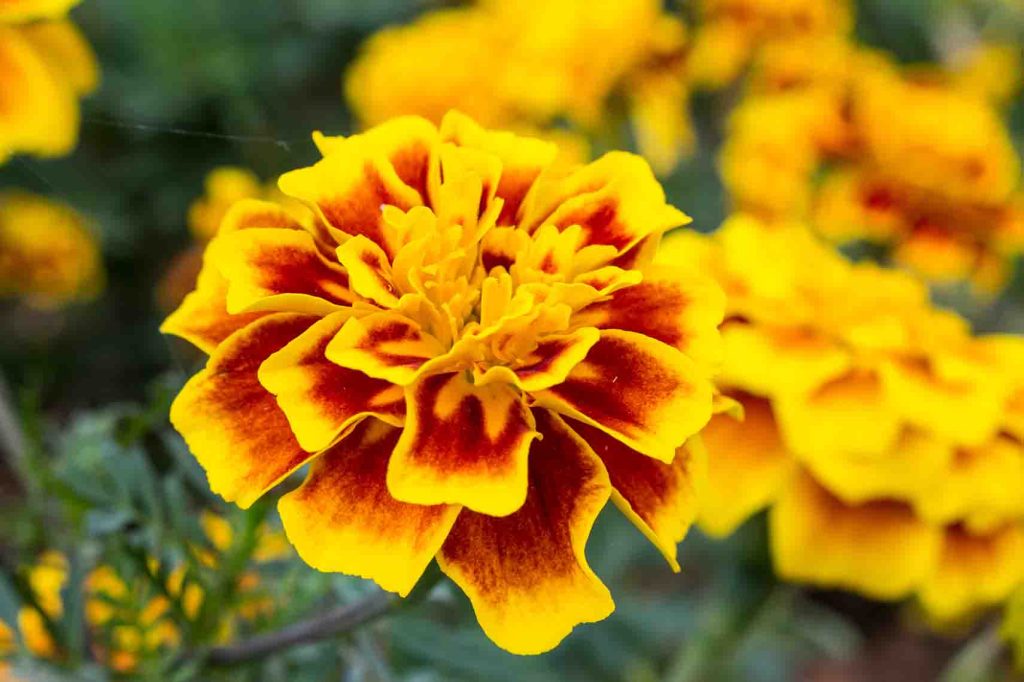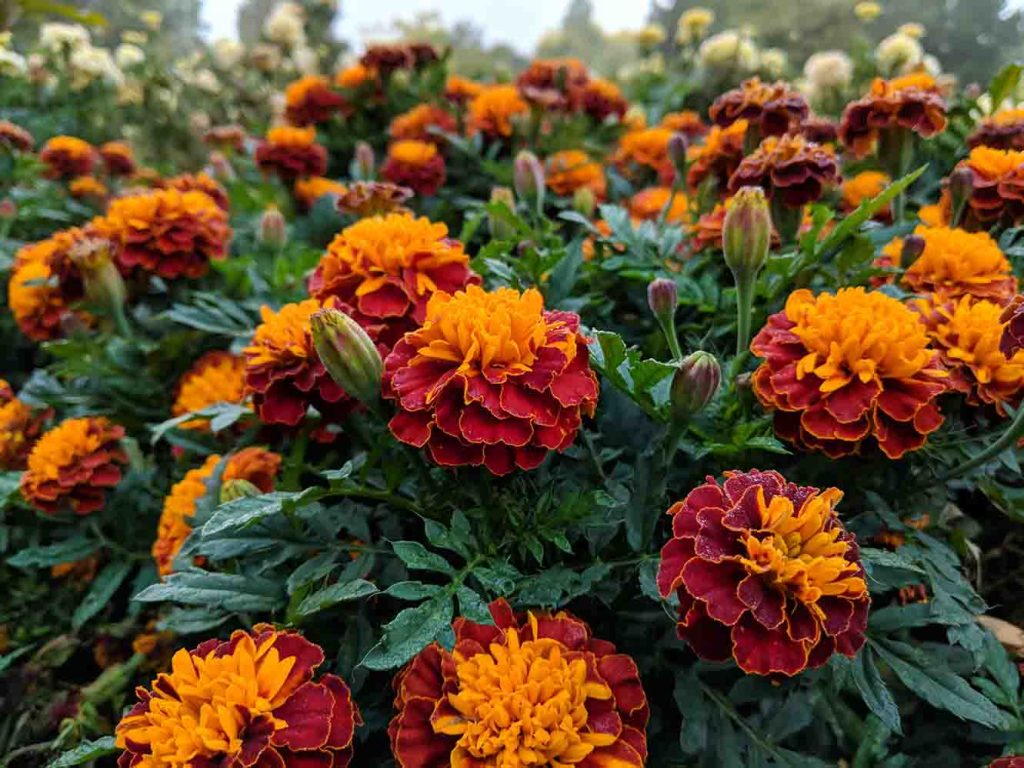
Marigolds are widely regarded as a low-maintenance annual garden favorite. These cheerfully bright flowers are hardy and tough and are known for being one of the few flowers that are considered pest-resistant and pest deterrents. Today, there are 56 varieties of marigolds found around the world.
History Of Marigolds

Marigolds are native to Mexico and were considered sacred in Ancient Aztec culture. Marigolds were used medicinally to treat conditions such as hiccups and aid digestion while also used to create salves that soothed and helped heal wounds. Aztecs also used this bright bloom in spiritual practices and rituals.
After the Spanish explorers made their way to the New World, it was said that many of them were so entranced by the vibrant colors of marigolds that they brought back the seeds to Spain, where they were grown and cultivated in monastery gardens. This resilient flower grew and thrived even in a vastly different climate.
From Spain, marigolds found their way all over Europe before eventually making their way to Africa. Marigolds developed many different traits with each new place they were grown, with a few species cross-pollinating with other flowers and creating new types of marigolds. They made their place as celebrated flowers in many cultures, with India adopting marigolds in religious ceremonies and celebrations, using garlands and wreaths of marigolds to decorate homes and temples. In Mexico, marigolds were scattered upon the graves of family members and left on altars in honor of All Souls Day and All Saints Day.
After the American Revolutionary War, marigolds became popular in the Americas and a popular flower found in nationwide gardens. Since then, marigolds have been cultivated into various types of flowers, such as white marigolds, odorless marigolds, tall marigolds, and countless other hybrid flowers. Marigolds have earned their place in multiple cultures throughout history, and their reign of supremacy as one of the most popular garden flowers continues to this day.
Growing Marigolds

Today, marigolds are easily the most recognizable flower in the garden. They are easy to cultivate and grow, need little maintenance, and make an excellent companion flower to any garden. These bright, joyful flowers are happy to deter pests and even improve soil health while they grow vigorously all summer long.
Marigolds can happily be planted with little fuss. Buying a potted plant from a nursery or store is simple enough to add to a garden. When taking the marigolds out of the pot, inspect the plants for any signs of girdling.
Girdling is when the plant’s roots grow horizontally in a circle, which keeps roots from getting a firm grip in the soil and can cause the plants to die. Marigolds planted in pots are especially susceptible to girdling due to their extensive root system.
If you see the ball of roots clumped together at the bottom of the marigold, the best solution is to rip the tangled root ball right out. It will be stressful for them, but the natural response of this tough annual is to immediately establish new roots that will create a firm hold in the ground. After a brief breaking-in period, the marigolds will thrive with few, if any, issues.
Growing From Seedlings

Alternatively, marigold seeds can be bought, and you can start growing the pretty flowers on your own. Since marigolds are widely considered excellent beginner flowers, they are fairly simple to start growing.
The easiest way to grow marigolds is to sow the seeds in biodegradable seed starting trays indoors about 50 days before the last frost date. Cover the starting trays with a thin layer of vermiculite, perlite, or potting mix. While marigolds don’t need sunlight to germinate, experts recommend using a clear plastic lid to cover the top of the tray, giving it a greenhouse effect.
It could take seedlings up to a week to germinate, at which point they would need about six hours of sunlight a day. The seedlings must be thinned out once they start producing a second set of leaves. Once the leaves are thinned, the seedlings could be transferred to their own pot and kept there until they can plant outside.
Water Requirements

The standard practice with planting marigolds, or any plant really, in your garden is to soak the soil deeply and thoroughly. Deeply watering the soil immediately after planting them gives them a chance to settle into the fresh soil and gives them a nice drink to jumpstart their growth in their new home.
Once marigolds are established in the garden, they are fairly low maintenance in terms of watering. Deeply watering them once a week is more than enough. In fact, unless it’s unusually hot and dry, marigolds can often thrive on rainfall alone.
Be mindful of not overwatering marigolds, as they are susceptible to root rot. It’s best to water when the top few inches of soil are dry to the touch and not to water directly from the top. The petals of a marigold can turn into a brown, wilted mess if they get too wet.
Sun Requirements

Marigolds are native to sunny and warm climates, thriving in full sun with rich soil. These tough flowers can easily withstand full sun exposure, only showing signs of stress in extreme weather conditions, be it too dry or too humid.
Though marigolds can bloom in partial sun, the blooms are rarely as vibrant and full as they are when marigolds grow in full sun. Marigolds in the shade are more susceptible to root rot and all sorts of problems that affect the leaves, stem, and petals. This bright, colorful plant is at its best in the spotlight.
The Perfect Companion Plant
Some varieties of marigolds are known for giving off a strong scent that, while not offensive to humans, is known to deter common garden pests. Harmful bugs and even some animals that are known to snack on and destroy plants in gardens frequently are deterred by the scent of marigolds. The roots of marigolds are also known to repel nematodes. These factors make it the perfect companion plant.
Many gardeners choose to plant marigolds as companion plants to surround vulnerable plants they hope to protect from common garden pests. This is why you often see marigolds planted in fruit and vegetable gardens.
Three Main Types Of Marigolds

Officially, 56 varieties of marigolds are recognized, not including the hybrids. Of those varieties, three types are most commonly found in gardens all over the world. Most of these varieties fall into three categories: French marigolds (pictured above), African marigolds, and signet marigolds.
French Marigolds
French Marigolds (Tagetes patula) are daintier and compact, growing between 6 to 12 inches tall compared to the other types. There are both double and single-flower varieties, but double flower varieties are the most common. The blooms grow up to two inches wide, with deep and rich yellows, oranges, and reds.
French marigolds give off a summery scent and are commonly the variety that’s found in bouquets used for special occasions.
African Marigolds
Easily the most impressive of marigolds, African marigolds (Tagetes erecta) are the biggest of all the marigolds, with varieties growing up to five feet tall. The giant five inch wide blooms stand out in any garden with the vibrant oranges and yellows that stand tall and proud.
These tall beauties with large flowerheads often require stakes to grow upright without drooping, but the effort is well worth it. They grow aggressively, outcompeting many other plants for space in a potted plant or a garden, and do require a little more care to manage than their easy-going cousins, French marigolds.
Signet Marigolds
The smallest of the marigolds, signet marigolds (Tagetes Tenuifolia), rarely grow taller than six inches. Signet marigold flowers are only about an inch long and grow in clusters, spreading so rapidly that it often makes it challenging to keep up with their growth when planted in a garden.
Signet marigolds are edible and often used in salads or as a garnish. They contain high levels of vitamin C and antioxidants, and have been used for medicinal purposes for centuries. The flower has anti-inflammatory benefits and has been used across many cultures to help with issues such as:
- cancer
- ulcers
- arthritis
- eczema
- warts
- allergies
- digestion
- eye diseases
Signet marigolds are the variety that are used as companion plants in gardens, protecting vulnerable plants from pests. Though they are the smallest of the marigold types, they certainly pack the biggest punch.
Floriography Of Marigolds

Floriography is known as the ‘language of flowers’ and has been practiced for thousands of years across different cultures. Meanings and messages are assigned to flowers and plants from all over the world.
Marigolds are often associated with positive energy and emotions. Often referred to as the “herb of the sun,” the flowers’ vibrant yellow, orange, and red colors are associated with happiness, warmth, optimism, joy, and good luck.
In contrast, marigolds can also symbolize jealousy, despair, and mourning, depending on the other flowers paired within an arrangement.
Marigolds are also associated with resurrection and honoring the dead in many cultures.



